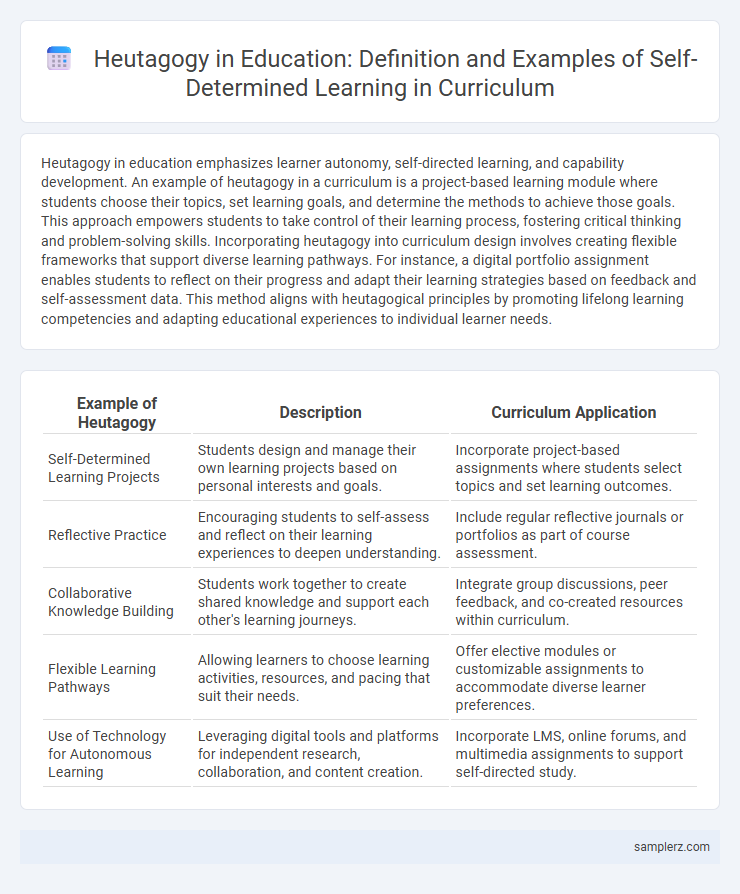Heutagogy in education emphasizes learner autonomy, self-directed learning, and capability development. An example of heutagogy in a curriculum is a project-based learning module where students choose their topics, set learning goals, and determine the methods to achieve those goals. This approach empowers students to take control of their learning process, fostering critical thinking and problem-solving skills. Incorporating heutagogy into curriculum design involves creating flexible frameworks that support diverse learning pathways. For instance, a digital portfolio assignment enables students to reflect on their progress and adapt their learning strategies based on feedback and self-assessment data. This method aligns with heutagogical principles by promoting lifelong learning competencies and adapting educational experiences to individual learner needs.
Table of Comparison
| Example of Heutagogy | Description | Curriculum Application |
|---|---|---|
| Self-Determined Learning Projects | Students design and manage their own learning projects based on personal interests and goals. | Incorporate project-based assignments where students select topics and set learning outcomes. |
| Reflective Practice | Encouraging students to self-assess and reflect on their learning experiences to deepen understanding. | Include regular reflective journals or portfolios as part of course assessment. |
| Collaborative Knowledge Building | Students work together to create shared knowledge and support each other's learning journeys. | Integrate group discussions, peer feedback, and co-created resources within curriculum. |
| Flexible Learning Pathways | Allowing learners to choose learning activities, resources, and pacing that suit their needs. | Offer elective modules or customizable assignments to accommodate diverse learner preferences. |
| Use of Technology for Autonomous Learning | Leveraging digital tools and platforms for independent research, collaboration, and content creation. | Incorporate LMS, online forums, and multimedia assignments to support self-directed study. |
Integrating Heutagogy into Modern Curriculum
Integrating heutagogy into modern curriculum involves promoting self-determined learning where students design their learning paths, set goals, and reflect on their progress to enhance autonomy and lifelong learning skills. Project-based assignments and digital portfolios serve as practical tools, enabling learners to apply knowledge creatively and track their development. This approach aligns with personalized education trends, fostering critical thinking, adaptability, and intrinsic motivation.
Student-Driven Learning Approaches in Practice
Student-driven learning approaches in heutagogy emphasize autonomous curriculum choices, allowing learners to set personalized goals and pursue knowledge relevant to their interests and needs. Examples include project-based learning, where students select topics and methods of inquiry, and self-assessment strategies that enhance metacognitive skills. This approach fosters deeper engagement, critical thinking, and adaptability by empowering students to take ownership of their educational journey.
Real-World Examples of Heutagogy in Classrooms
Heutagogy in classrooms emphasizes self-determined learning through real-world projects, such as students designing sustainable solutions for local environmental issues. This approach encourages critical thinking and autonomy by allowing learners to set goals, select resources, and reflect on outcomes. Implementing case-based learning and community engagement fosters practical skills aligned with 21st-century competencies.
Designing Self-Determined Learning Activities
Designing self-determined learning activities in curriculum involves creating flexible tasks that empower students to set their own goals, choose resources, and evaluate their progress independently. Activities such as project-based assignments, open-ended research tasks, and reflective journals foster autonomy and metacognition, key principles of heutagogy. Incorporating digital tools and collaborative platforms further enhances learners' capacity to direct their educational journey while developing critical thinking and problem-solving skills.
Heutagogical Methods in Higher Education Programs
Heutagogical methods in higher education programs emphasize self-determined learning where students actively design their curriculum, set learning goals, and evaluate outcomes, fostering deep critical thinking and autonomy. Techniques such as project-based learning, reflective journaling, and peer teaching promote metacognitive skills and lifelong learning habits essential for complex problem-solving in academic and professional contexts. Integrating digital platforms and collaborative tools further enhances personalized learning pathways, enabling students to adapt knowledge to evolving disciplines and real-world challenges.
Authentic Assessment through Heutagogy
Authentic assessment through heutagogy emphasizes learner-driven evaluation methods such as self-reflection, peer feedback, and real-world problem-solving tasks that mirror professional contexts. This approach empowers students to take control of their own learning by setting goals, selecting resources, and applying knowledge in practical scenarios that foster critical thinking and adaptability. Integrating authentic assessment within heutagogical curricula enhances intrinsic motivation and lifelong learning skills essential for success in dynamic educational environments.
Empowering Learners with Choice and Autonomy
Heutagogy in curriculum design emphasizes empowering learners by providing flexible pathways and allowing self-directed goal setting, fostering autonomy in the educational process. Students engage in personalized projects and reflective practices that cultivate critical thinking and lifelong learning skills. This approach transforms traditional teacher-led instruction into a learner-centered environment, enhancing motivation and ownership of knowledge acquisition.
Teacher Roles in Heutagogical Curriculum Models
Teachers in heutagogical curriculum models act as facilitators and co-learners, guiding students to take ownership of their learning process. They design flexible, student-centered environments that promote self-directed inquiry, critical thinking, and collaborative problem-solving. This shift empowers learners to develop metacognitive skills and adaptive expertise essential for lifelong learning.
Technology-Enhanced Heutagogical Practices
Technology-enhanced heutagogical practices in education include the use of adaptive learning platforms that allow students to set personalized goals and explore content at their own pace, fostering self-determined learning. Examples include virtual simulations, interactive multimedia resources, and collaborative online tools that encourage critical thinking and self-reflection. These technologies support learner autonomy by providing real-time feedback and enabling iterative knowledge construction in diverse digital environments.
Measuring the Impact of Heutagogy on Student Outcomes
Measuring the impact of heutagogy on student outcomes involves assessing learners' ability to self-direct, critically reflect, and apply knowledge in real-world contexts. Tools such as reflective journals, portfolio assessments, and competency-based evaluations provide quantitative and qualitative data on skill acquisition and metacognitive growth. Studies indicate that curricula incorporating heutagogical principles enhance student autonomy and improve problem-solving abilities compared to traditional pedagogical approaches.

example of heutagogy in curriculum Infographic
 samplerz.com
samplerz.com